|
Oceanic trench (Geographic distribution)
There are about 50,000 km of convergent plate margins, mostly around the Pacific Ocean – the reason for the reference “Pacific-type” margin - but they are also in the eastern Indian Ocean, with relatively short convergent margin segments in the Atlantic Ocean and in the Mediterranean Sea. Trenches are sometimes buried and lack bathymetric expression, but the fundamental structures that these represent mean that the great name should also be applied here. This applies to Cascadia, Makran, souther...
|
|
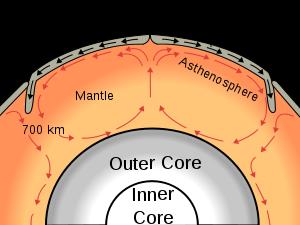 Oceanic Trench (General)
Oceanic Trench (General)
The oceanic trenches are hemispheric-scale long but narrow topographic depressions of the sea floor. They are also the deepest parts of the ocean floor. Trenches define one of the most important natural boundaries on the Earth’s solid surface, that between two lithospheric plates. There are three types of lithospheric plate boundaries: divergent (where lithosphere and oceanic crust is created at mid-ocean ridges), convergent (where one lithospheric plate sinks beneath another and returns to the ...
|
|
|
Mariana Trech
The Mariana Trench (or Marianas Trench) is the deepest part of the world’s oceans and the deepest location on the surface of the Earth’s crust. It has a maximum depth of about 10,911 meters (35,798 feet; 6.78 miles), and is located in the western North Pacific Ocean, to the east and south of the Mariana Islands, near Guam. The trench forms the boundary between two tectonic plates, where the Pacific Plate is subducted beneath the small Mariana Plate. At the bottom, the water column above exerts a...
|
|
|
Scuba Set Accessories
Accessories In modern scuba sets, a buoyancy compensator (BC) or buoyancy control device (BCD), such as a back-mounted wing or stabiliser jacket (otherwise known as a `stab jacket`), is built into the scuba set harness. Although strictly speaking this is not a part of the breathing apparatus, it is usually connected to the diver`s air supply, in order to provide easy inflation of the device. This can usually also be done manually via a mouthpiece, in order to save tank air while on the surface. ...
|
|
|
Air Cylinder
Air cylinders Air cylinders used for scuba diving come in various sizes and materials and are typically designated by material (aluminium, steel, high-pressure steel, etc) and by how much air (in cubic feet) they contain at 1 atmosphere (80, 100, 120, etc). The most common is the "Aluminum 80", which will give an average experienced diver from 40 to 60 minutes of dive time under common dive conditions. Air cylinder pressure will vary according to the type of material used, ranging from 2000 psi ...
|
|
|
Duration of a dive (open-circuit)
Duration of a dive (open-circuit) The duration of an open-circuit dive depends on factors such as the capacity (volume of gas) in the diving cylinder, the depth of the dive and the breathing rate of the diver. An open circuit diver whose breathing rate at the surface (atmospheric pressure) is 15 litres per minute will consume 3 x 15 = 45 litres of gas per minute at 20 metres. [(20 m/10 m per bar) + 1 bar atmospheric pressure] × 15 L/min = 45 L/min). If an 11 litre cylinder filled to 200 bar is u...
|
|
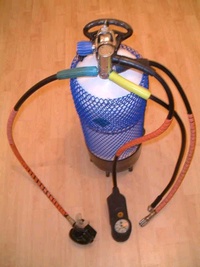 Single Hose Open Circuit Scuba
Single Hose Open Circuit Scuba
"Single-hose" open-circuit scuba Most modern open-circuit scuba sets have a diving regulator consisting of a first-stage pressure-reducing valve fastened over the diving cylinder`s output valve. This valve cuts the pressure from the cylinder, which may be up to 300 bar, to a constant lower pressure, often about 10 bar above the ambient pressure, which is used in the "low pressure" part of the system. A relatively thin low-pressure hose links this with the second-stage regulator, or "demand valve...
|
|
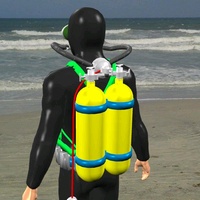 Twin Hose open circuit scuba
Twin Hose open circuit scuba
"Twin-hose" open-circuit scuba This is the first type of diving demand valve which came into general use, and the one that can be seen in classic 1960s SCUBA adventures, such as TV`s Sea Hunt. In this type of set, the two (or occasionally one or three) stages of the regulator are in a large circular valve assembly mounted on top of the cylinder pack. This type has two wide breathing tubes like those on many modern rebreathers, one for intake and one for exhalation. The return tube was not for re...
|
|
|
Opens circuit Scuba Set
The duration of open-circuit dives is shorter than a rebreather dive, in proportion to the weight and bulk of the set. It can be uneconomic when used with expensive gas mixes such as heliox and trimix. Most divers use standard air (i.e. 21% Oxygen / 79% Nitrogen). The cylinder is nearly always worn on the back. "Twin sets" with two backpack cylinders were much more common in the 1960s than now; although twin cylinders (aka "doubles") are commonly used by technical divers for the increased durati...
|
|
|
Type of Scuba Set
A scuba set is an independent breathing set that provides a scuba diver with the breathing gas necessary to breathe underwater during scuba diving. It is much used for sport diving and some sorts of work diving. The word SCUBA is an acronym for Self-Contained Underwater Breathing Apparatus. These initials originated in 1939 in the US Navy to refer to US military diver`s rebreather sets. As with radar, the acronym has become so familiar that it is often not capitalized and is treated as an ordina...
|
|
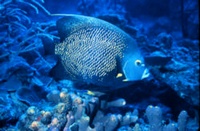 Marine Angel Fish
Marine Angel Fish
Marine angelfish are perciform fish of the family Pomacanthidae. They are found on shallow reefs in the tropical Atlantic, Indian, and mostly western Pacific oceans. The family contains seven genera and approximately 86 species. They should not be confused with the freshwater angelfish, tropical cichlids of the Amazon River basin. With their vibrant colours and deep, laterally compressed bodies, marine angelfishes are some of the more conspicuous residents of the reef. They most closely resemble...
|
|
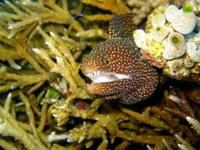 Moray eels
Moray eels
Moray eels are large cosmopolitan eels of the family Muraenidae. There are approximately 200 species in 15 genera. The typical length for a moray is 1.5 m (5 ft), with the largest being the slender giant moray, Strophidon sathete, at up to 4 m (13 ft). The dorsal fin of the moray extends from just behind the head, along the back and joins seamlessly with the caudal and anal fins. Most species lack pectoral and pelvic fins, adding to their snake-like appearance. Their eyes are rather small; moray...
|
|
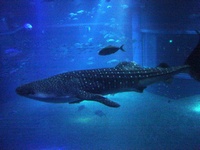 Whale Shark
Whale Shark
The whale shark, is a slow filter feeding shark that is the largest living fish species. This distinctively-marked shark is the only member of its genus Rhincodon and its family, Rhincodontidae (called Rhinodontes before 1984), which is grouped into the subclass Elasmobranchii in the class Chondrichthyes. The shark is found in tropical and warm oceans and lives in the open sea. The species is believed to have originated about 60 million years ago. The name "whale shark" comes from the fish`s phy...
|
|
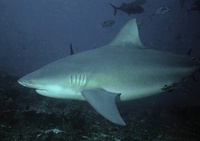 Bull Sharks
Bull Sharks
The bull shark, Carcharhinus leucas, also known as the bull whaler, Zambezi shark or informally Zambi in Africa and Nicaragua shark in Nicaragua, is common worldwide in warm, shallow waters along coasts and in rivers. The bull shark is well known for its unpredictable, often aggressive behavior. Many scientists agree that since bull sharks often dwell in shallow waters, they may be more dangerous to humans than any other species. Unlike most other marine sharks, bull sharks tolerate fresh water....
|
|
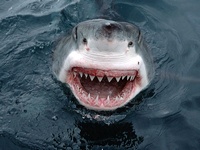 Shark Attacks
Shark Attacks
A shark attack is an attack on a human by a shark. Every year, a number of people are attacked by sharks, although most survive. Despite the relative rarity of shark attacks, the fear of sharks is a common phenomenon, having been fueled by the occasional instances of attacks, such as the Jersey Shore shark attacks of 1916, and by sensationalized fiction and film, such as the Jaws series. Many shark experts feel that the danger presented by sharks has been exaggerated, and even the creator of the...
|
|
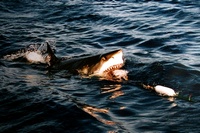 Diet of Great White
Diet of Great White
Great white sharks are carnivorous, and primarily eat fish (including rays and smaller sharks), dolphins, porpoises, whale carcasses and pinnipeds such as seals and sea lions. Sea otters and sea turtles are also taken at times. Great whites have also been known to eat objects that they are unable to digest. In great white sharks above 3.41 metres (11 ft, 2 in) a diet consisting of a higher proportion of mammals has been observed. These sharks prefer prey with high contents of energy-rich fat. Sh...
|
|
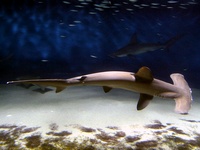 Hammerhead Shark
Hammerhead Shark
The nine known species of hammerhead range from 0.9 to 6 m long (3 to 20 feet). All the species have a projection on each side of the head that gives it a resemblance to a flattened hammer. The shark`s eyes and nostrils are at the tips of the extensions. The hammer shape of the head was once thought to act as a wing, aiding in close-quarters maneuverability and allowing the shark to execute sharp turns without loss of stability. However, it was found that the special design of its vertebra allow...
|
|
|
Great White Adaptations
Great white sharks, like all other sharks, have an extra sense given by the Ampullae of Lorenzini, which enables them to detect the electromagnetic field emitted by the movement of living animals. Every time a living creature moves it generates an electrical field and great whites are so sensitive they can detect half a billionth of a volt. Most fish have a less developed but similar ability in the horizontal line along their body. To more successfully hunt fast moving and agile prey such as sea...
|
|
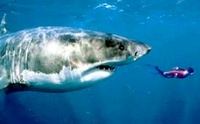 Great White - 04
Great White - 04
Some researchers questioned the reliability of both measurements, noting they were much larger than any other accurately-reported Great White Shark. The New Brunswick shark may have been a misidentified basking shark, as both sharks have similar body shapes. The question of the Port Fairy shark was settled in the 1970s, when J.E. Reynolds examined the shark`s jaws and "found that the Port Fairy shark was of the order of 5 m (17 feet) in length and suggested that a mistake had been made in the or...
|
|
|
Great White - 03
The Great White Shark has a robust large conical-shaped snout. It has almost the same size upper and lower lobes on the tail fin (like most mackerel sharks, but unlike most other sharks). Great White Sharks display countershading, having a white underside and a grey dorsal area (sometimes in a brownish or bluish shade). The colouration makes it difficult for prey to spot the shark because it breaks up the shark`s outline when seen from a lateral perspective. When viewed from above the darker sha...
|
|